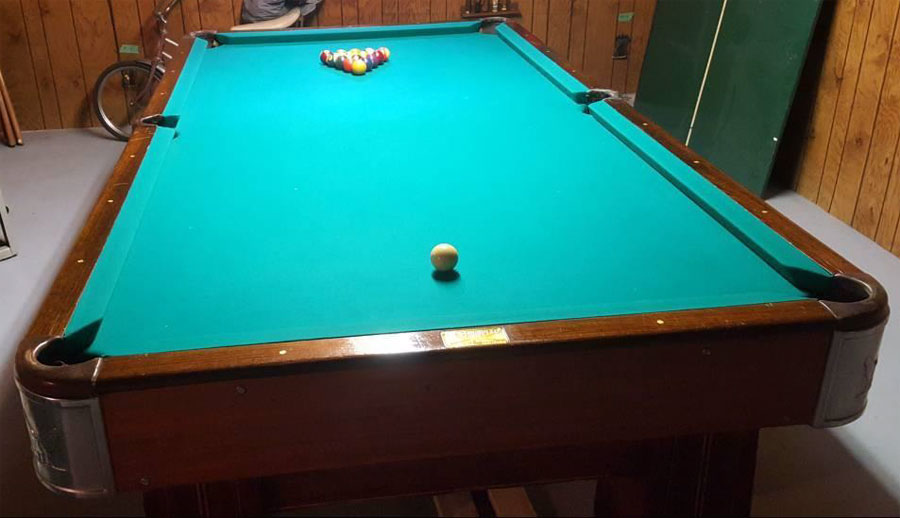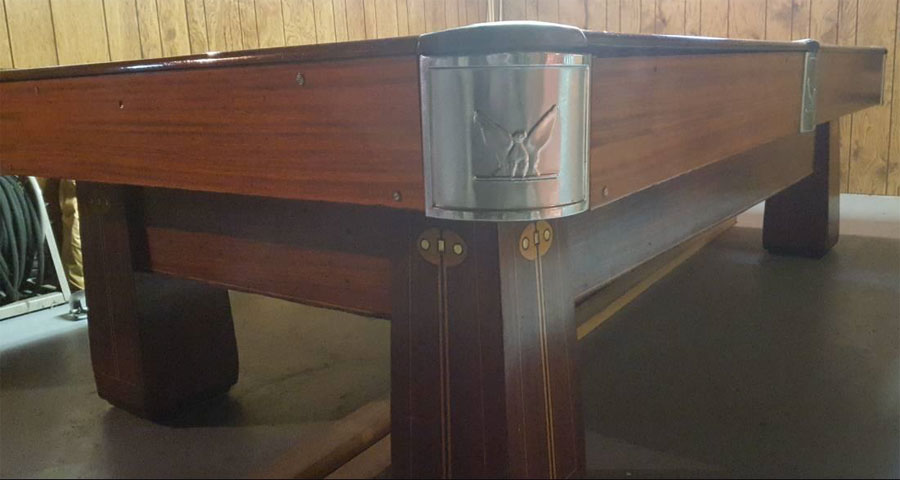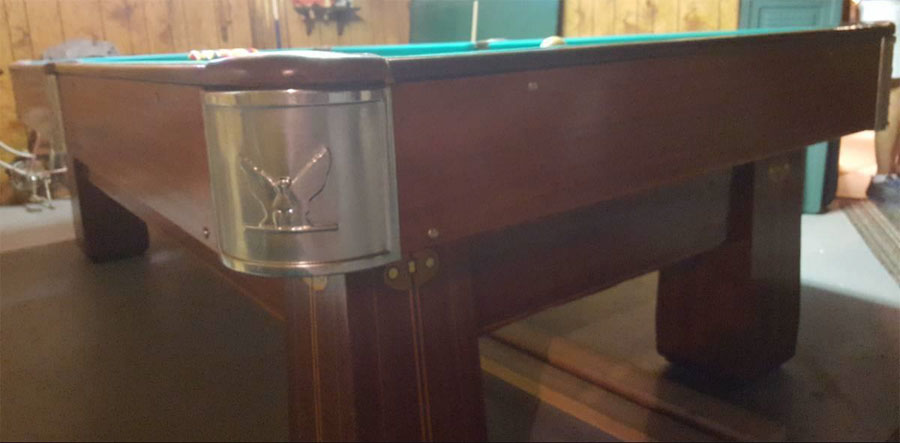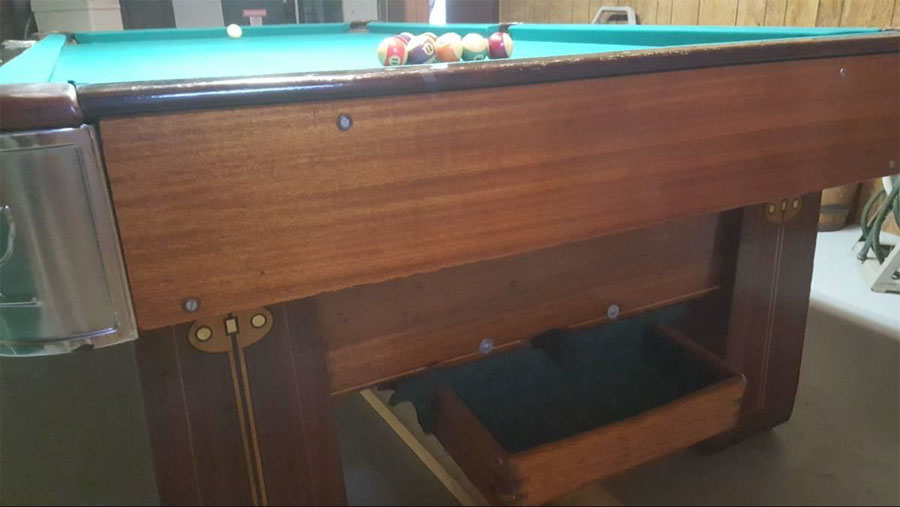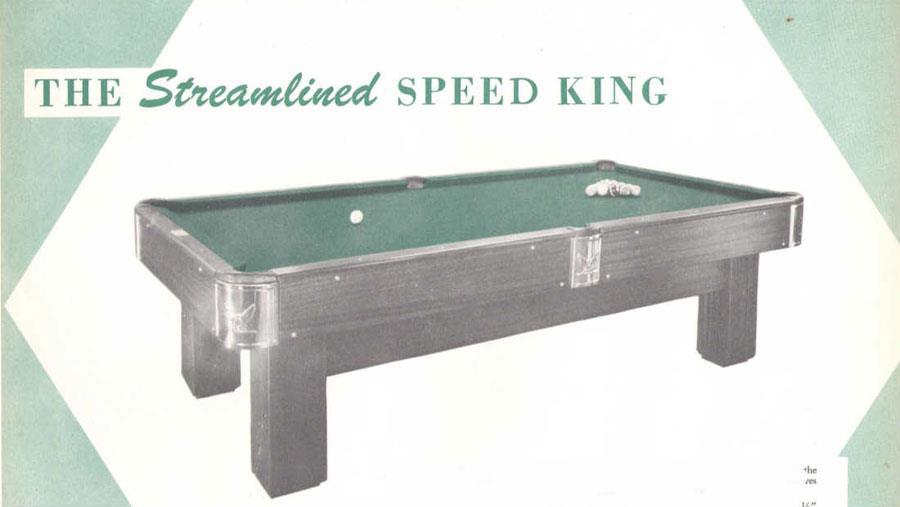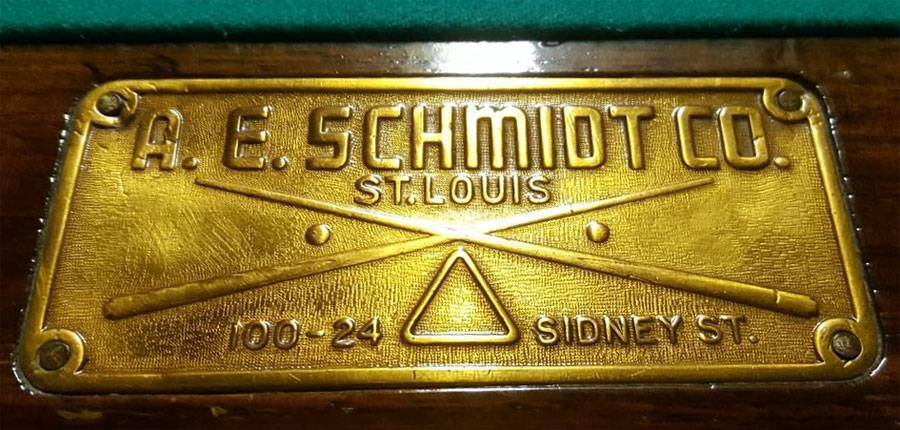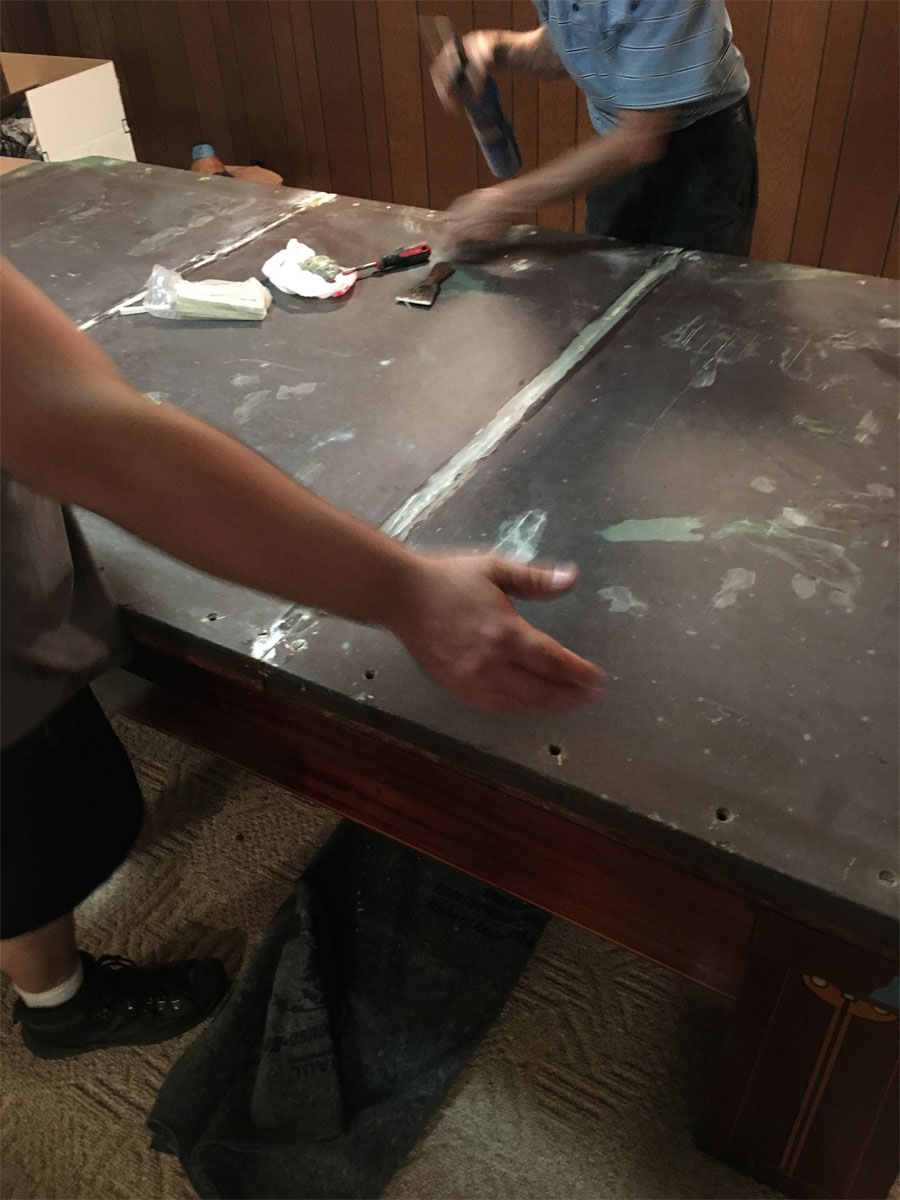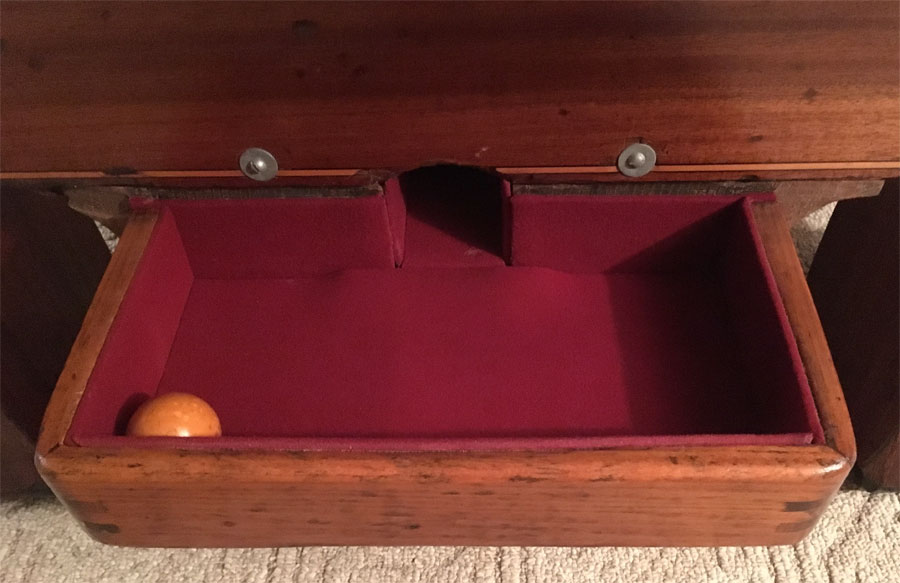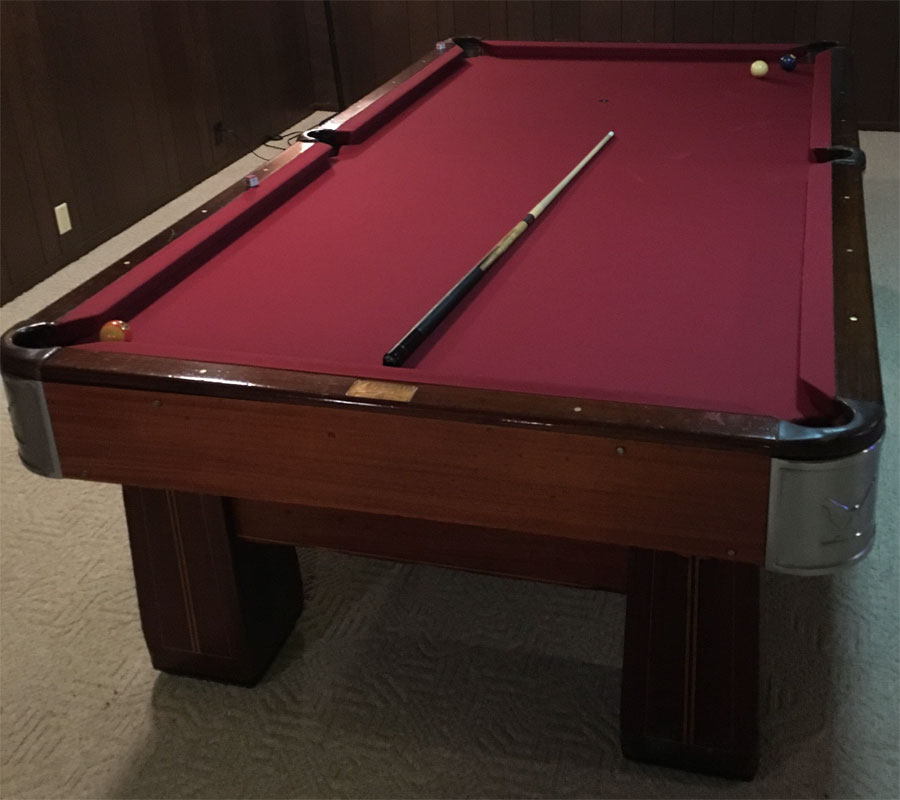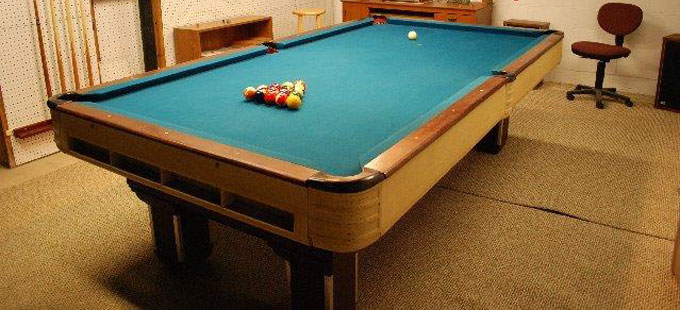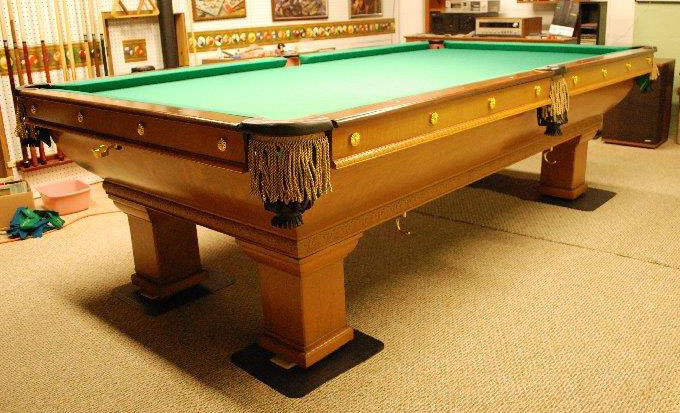1941 AE Schmidt Streamlined Speed King Value
9/19/2018 3:38:44 PM
1941 AE Schmidt Streamlined Speed King Value
I've got a 1941 AE Schmidt Streamlined Speed King, oversize 8' with ball return. It is in good shape for its age.
Any idea's on value? I'm not looking to sell or otherwise just trying to ascertain it's worth.
Here are some photos of the pool table:
1941 AE Schmidt Streamlined Speed King Value
Replies & Comments
 billiardsforum on 9/19/2018 4:24:48 PM
billiardsforum on 9/19/2018 4:24:48 PMNice pool table. Few questions:
- Are the rail aprons real wood?
- Those screws which are visible from the outside - are they original, or were they put in at some point to repair the table?
- Can you show a clear photo of the A.E. Schmidt name plate?
Also, I am curious as to how you came to know the exact year and model name of the pool table.
user1537396724 on 9/20/2018 7:03:47 AM
The screws that are visible on the skirts are 100% original. The only Screws I'd question the originality of are the two that are holding the ball return drawer visible in the last pic.
I determined the table model from A.E. Schmidt's historical database found here:
Streamlined Speed King Pool Table
Description:
Another Schmidt Company bargain in Carom Billiard, Pocket Billiard, or Snooker tables for those who may want a modernized low priced table. Except for the addition of the wide panels and pocket shields, the Streamlined Speed King is built exactly as is our plain Speed King. It is substantially constructed of ¾’ plywood and is veneered with American Walnut.
Tables are furnished with three piece, one inch slate mounted on well braced, heavy frames; fast, accurate rubber cushions; pocket nets and leathers of the best quality; streamlined blind panels and chrome plated pocket shield. The streamline Speed King may be ordered in 4 x 8, 4 ½ x 9, or 5 x 10 sizes; four legs on the 4 x 8 and 4 ½ x 9 sizes – six legs on the larger, 5 x 10.
Legs, sides and panels are constructed of 3/4’’ laminated plywood, faced with 1/8” Marlite, mahogany finish. Frame and braces are heavy fir lumber, securely laminated and bolted together. Black walnut rail tops, leather covered #6 pocket irons and sagless leather pocket nets.
- Manufactured from 1937-1949
- Available in Formica
- Slate Bed: 1” 3 piece
Source: aeschmidtbilliards.com/product/streamlined-speed-king
From their description the rails are black walnut, skirts and legs are veneered. I'll know more when I get it broken down. The year I also determined off of Schmidt's "serial numbers". I can confirm when I get it broken down but laying on my back under the table, the numbers indicated it was built in '41.
 billiardsforum on 9/25/2018 3:51:58 AM
billiardsforum on 9/25/2018 3:51:58 AMYou have done a really good job researching the pool table thus far, and I don't have any further info than what you've already shown and shared.
For pool table valuation, we typically monitor the market (eBay, craigslist, other pool table dealers) for recent comparable sales.
I've not found any identical pool tables having sold recently, but a few similar. Yours is in much better shape than those were. Typical price was around $500 on the ones I saw.
Best you can do now is create alerts for yourself on the various classified sites, and make notes as the sales occur.
Please don't take the following as an insult. Just an honest account of my observations of the market over the past 5-10 years.
One thing I find in almost all cases with antique pool tables from this era - they never sell for what the owners think they are worth. The used pool table market (especially for 1925s to 1980s pool tables) is very weak. The styles are outdated, and trapped somewhere between "timeless classic solid wood furniture-style pool tables" (e.g. 1920s and earlier) and the pool tables from the late 1980s onward that fit in more with modern decor. Your AE Schmidt pool table, while very nice, isn't particularly collectible nor is it a sought-after brand or model by folks who collect antique billiard items. Folks who are after a high-end antique pool table are typically looking at the 1900s-era Brunswick Balke Collender models or even the pre-1900 A.E. Schmidt tables.
What I have seen over the past 5 years or so is folks giving away pool tables like yours (or selling for next to nothing) e.g. perhaps they inherited it after the death of a relative or parent, and don't really care for the game and don't want/don't have room for a pool table. They just want it gone. These "give-away" prices make it hard for folks with a nicer pool table like yours to get a proper sale price.
If you want to get a good price for the table, the best way to do that is with time. If you aren't in a rush to sell it, and can afford to wait for the right buyer, then you'll do better.
Either way, let us know how you get on.
user1537396724 on 9/25/2018 7:22:59 AM
Thanks for your insight and perspective on the market. I know what you've said holds true as I came about the table in an estate sale in which the family just wanted it gone. As a result I picked it up for what I felt was below its market value.
The good news is I'm not buying it for an investment or to flip it and have no interest in selling it. I bought it because I love the look of the table, it fits my taste, and I'm going to enjoy playing on it. Also it's a Schmidt which I've always wanted and its quality will serve me well for many years of play.
The one thing about it that has me scratching my head at this point is the ball return system. I'm having trouble figuring out if it was original, if it was a custom option that Schmidt added, or if someone added it on at some point in its life. I can't find any detail on it. Once I break it down and move it, I plan on contacting Schmidt with all the info I can gather and see if they can give me any information.
Thanks again for all your help thus far.
 billiardsforum on 9/26/2018 4:13:22 AM
billiardsforum on 9/26/2018 4:13:22 AMAny time. Also, if you get any info from the A.E. Schmidt Co., please do let us know.
user1537396724 on 10/29/2018 9:45:22 AM
I thought I'd update this question with what I found after breaking down the A.E. Schmidt pool table, moving it, and reassembling it.
The serial numbers on the table were C4116. This indicates that it was the 216th table built in 1941. "A" would be the first 1-99, "B" would be 100-199, "C" 200-299, and so on. 2nd two characters represents the year, and last two, the sequence within the range of 1-99 for that group of 100s.
The pool table is almost all original. One of the rail skirts has a different serial number and one of the pocket shields is stamped out of what should have been the correct numerical sequence. I suspect the table was damaged at some point and these were original Schmidt repair parts, just stamped with the numbers when they were produced.
The ball return system appears 100% original and components show their age. Some minor damage at the ball return tray is why the two screws visible above the tray are there. Not a correct or original style repair.
One day I'd love to have a full restoration performed.
The table plays great and the cushions are super fast, especially given their age. I had the table re-felted with Simonis 860 upon reassembly.
Here are some pics:
Waxing the joints, before felt.
Cloth on. Almost done.
I rehabbed the return tray. It still needs to be taken fully apart and repaired correctly, but that can wait for a restoration. At least the AstroTurf that it was line with is gone!
Ready for play.
 billiardsforum on 10/30/2018 2:06:13 AM
billiardsforum on 10/30/2018 2:06:13 AMYour pool table looks great, thanks for sharing the photos of the cloth installation.
Looks like it's all ready for a lot of great games.
 user1501895785 on 11/16/2019 5:45:52 PM
user1501895785 on 11/16/2019 5:45:52 PMIt looks like your pool table is more a hybrid with Brunswick Regina legs and stretchers, married to AE Schmidt rails, pockets, and aprons.
What does the ball return look like on your AE Schmidt pool table?
If it is more the mousetrap wooden ball return with each ramp going down towards the center of the table, that is more a 1920 vintage system.
I'm not sure the stamped numbers really give any clue to date of production, probably more a nomenclature to keep the parts of a table together.
Since A. E. Schmidt is still in existence, it would be helpful to see what they say about the pool table.
user1537396724 on 11/16/2019 6:45:44 PM
You're post is timely and very correct. I just moved for work and throughout the move process have found some interesting information.
The pool table itself is a Brunswick Balke Collender Regina pool table built between 1914 and 1926.
In the 1940's (1941 in this case) Brunswick felt that their tables were disposable and wouldn't repair them if rail damage was incurred etc. A.E. Schmidt offered an aftermarket kit that resembled the Schmidt Speed King that would restore the Brunswick tables to playability. This was at the height of the market wars between A.E. Schmidt and Brunswick Balke Collender.
My pool table was repaired and re-tagged in 1941 by A.E. Schmidt but is an original Brunswick Regina pool table.
All of the information I've gleaned is courtesy of Curt Schmidt at AE Schmidt. I contracted them for setup when I moved and they were instrumental in the discovery process of what the history of the pool table is. Curt advised that A.E. Schmidt never offered a ball return system, and the 1.5" thick slate was another indicator of the interesting story of the table.
Still lots of data about this pool table to be uncovered through further investigation.
 user1501895785 on 11/17/2019 3:45:34 AM
user1501895785 on 11/17/2019 3:45:34 AMBrunswick themselves offered a "modernization" kit using similar (albeit, newer) table rails and aprons for these older pool tables.
I have seen many times where the local pool table company here back in the 1960s and 1970s did a spray paint modernization to the older pool tables instead of a sand and refinish of the veneer. Sometimes adding metal strips or fitted wood corner trim to hide the previous damage the legs had suffered.
Various manufacturers including Brunswick and Victor Billiards did a similar spattered/speckled finish as well starting in the late 1930s, 1940s, and up into the 1960s, on several of their models, again getting away from the nicer veneer that was used prior.
 billiardsforum on 11/17/2019 4:43:19 AM
billiardsforum on 11/17/2019 4:43:19 AMThis is great information.
@user1537396724 - thank you so much for following up with the extra information you found with the help of the A.E. Schmidt Billiards Co.
@user1501895785 - thanks for sharing the additional details and insight about this part of the pool table service industry.
It was a sad day when someone came up with those spattered/speckled finish.
 user1501895785 on 11/17/2019 6:16:01 AM
user1501895785 on 11/17/2019 6:16:01 AMBrunswick had a modernization kit to "renew" or convert the older tables to a more modern look. They would use 20th Century rails, aprons, and metal corner shields like the A.E. Schmidt ones you have but the longer aprons would hide the nice majestic bodies of the older tables so it was a bit of a mismatch.
Many of Brunswick tables in late 1930s, including the Series I Gold Crowns of the 1960s, were factory painted (the GCs were painted in a standard effect, not spattered). The spattered/speckled look was sort of "granite-like" - pleasing to the eye. I guess that is why the local company, when they took in a lot of tables, did this to refresh them. Many of these pool tables were the plain vanilla types without the inlays, but it was a way to hide all the cosmetic issues of a now-40-year old pool table that was in a pool hall or neglected. The look and effect wasn't too bad and I am sure that when it was fresh it looked just fine.
But fast forward another 40-50 years. Back in the 1960's-1970's, I guess wasn't too much of a concern to properly refurbish/restore a pool table. Actually the pool tables like yours with all the inlays, if not in good condition, would be a painstaking restoration, so in some ways doing a paint job was a short-cut. But I have only seen the older tables painted that did not have the inlays - the more "plain jane" tables, but they still had quarter-sawn oak or mahogany veneer underneath.
Again there was a time where they didn't use the veneers and just did the spattered look over the wood which was typically poplar wood and not amenable to staining.
user1537396724 on 11/17/2019 6:21:24 AM
So my question is this:
There will come a day when I have a full restoration performed. The ball return system needs the love.
- At that point should I restore back to what the pool table was born as originally, or should I restore it back to the table that it has become?
- How would either choice effect its value?
 billiardsforum on 11/17/2019 6:38:36 AM
billiardsforum on 11/17/2019 6:38:36 AMBecause it is a "frankenstein" pool table now, it will have little value to an antique pool table collector (the cohort from which you would typically receive the best price).
One thing you have going for it is that you know the history, and have correspondence from a reputable source (the A.E. Schmidt family). Having documented provenance helps it's value somewhat, but not by a whole lot given that it isn't all-original.
However, it sounds like this is a pool table that you personally really like, and will personally restore, and will perhaps keep around for some time. It's value to you is likely far more than you'd ever get in the market.
Based on the factors above, I would follow the path that most satisfies you and your family.
But if you were counting on selling it some day....
It is a Brunswick pool table at it's core, with an after-market A.E. Schmidt "refresh". The more you can bring it back to it's original Brunswick Balke Collender form, the more it'll be worth.
 user1501895785 on 11/17/2019 12:01:51 PM
user1501895785 on 11/17/2019 12:01:51 PMI had a Brunswick Newport/actually Saratoga with the 20th Century rails, aprons, and back metal pocket shields. It had been painted and had additional metal strips vertically along the legs to give it some flavor and had lost some of the molding along the lower part of the legs.
I was able to take off the "modernization", strip, and refinished it all in the original quarter-sawn oak, which was actually in nice condition. I fabricated the necessary leg moldings, aprons with the egg and dart trim, refinished the rails, and sent the pockets out for all new material. It all matched well and looks nice, and although it is not all original, I was able to get it back to its original intentions. It's hard to believe it is the same pool table
Before:
After:
1941 AE Schmidt Streamlined Speed King Value
- Title: 1941 AE Schmidt Streamlined Speed King Value
- Author: user1537396724
- Published: 9/19/2018 3:38:44 PM
- Last Updated: 9/20/2018 1:57:14 AM
- Last Updated By: billiardsforum (Billiards Forum)

